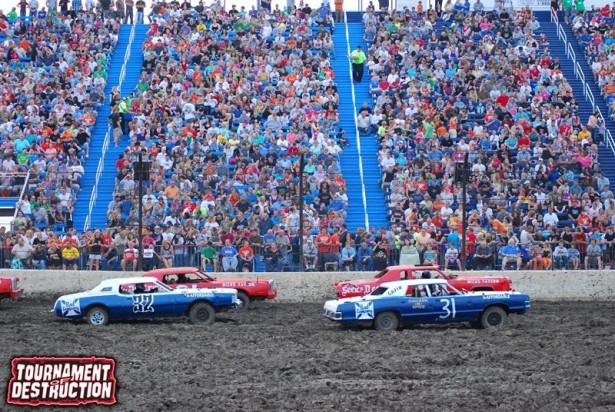Scheduling sporting events is one of those things that very few people think much about. Whether you’re watching a February Bulls game against the Nuggets or an August TDA race between Mean Green Machine and Stranglehold, fans rarely give the matter much thought. Of course the Bulls are playing the Nuggets! That’s what’s scheduled! Fans show up to the stadium, watch the events take place, drink 15 beers, give or take 5 beers, and go home. Not much time is ever spent pondering how that Bulls vs. Nuggets or Mean Green Machine vs. Stranglehold match up came to be.
I’m endlessly fascinated by these little things. And the way the TDA schedules its events is certainly just this: a fascinating little thing.
It used to be the case that the schedule was essentially (and occasionally literally) picked out of a hat. Each team would have one slip of paper with its name written on it put into said hat. Each team owner would then pull out a slip of paper to see what team they’d be racing in the first round. In such a way, it was entirely possible, though not probable, that one team could pull the same first round opponent every night of the season.
A few years ago, this, uh, system of scheduling changed to its current form. Prior to the season, the head of competition would make out seven different schedules (one for each possible permutation of first round opponents), puts them in a sealed set of envelopes and then lets one of the team owners randomly pick an envelope for the evening of racing.
It’s a slightly antiquated and somewhat confusing method of scheduling things, but this is also one of the more appealing parts of the situation. It’s one of the quirkier elements of a somewhat quirky sport. If I’m endlessly fascinated by little things, there aren’t really words out there to accurately describe how much I enjoy the quirkier elements of quirky sports.
However, after entirely too much thought about this, I began to wonder if tweaking this method of scheduling might allow the sport to make some very positive forward progress.
While the lack of transparency of the current scheduling system adds a level of mystery to things and does force each team to prepare as though it will face the best team in the league, there’s also another element to it.
Rumors abound everywhere behind-the-scenes in the TDA. Talk to a driver, any driver, and you can be guaranteed that he will be pondering a minimum of two different conspiracy theories at any given moment. The more far-fetched and ridiculous, the more popular these become. I spoke to a driver last year who was convinced that an opponent was putting railroad tracks inside their cars’ frames. It was so ludicrous I didn’t know what to say. If I put my mind to it, I’m pretty sure I could get a number of drivers believing that Reckoning’s Brian Anderson was contemplating an operation that would fuse adamantium with his bones, ala X-Man extraordinaire, Wolverine, so that he could both add extra weight to his car and use his left leg as an extra body bolt.* Throw a situation with sealed envelopes prepared by the people in charge into this mix and questions will quickly pop up for the drivers.
* Come to think of it, I might start on this right now. I believe I saw some pamphlets for the Weapon X Program lying around Anderson’s dining room the last time I was there…
I will state quickly, emphatically and unequivicably that there is no evidence or reason to think that any malfeasance has ever taken place in regards to the scheduling. This is not a Patrick-Ewing-lottery-being-fixed kind of denial either. There isn’t a driver out there who can point to any schedule in particular and make any kind of argument that he thinks it is rigged. Firstly, because such a thing doesn’t exist and secondly because TDA conspiracy theories aren’t based in fact as much as they are in gut feelings… or, more accurately gut fears.
And while the drivers’ worries that the scheduling was rigged was originally what got me thinking about the possibility of tweaking the system, it isn’t what caused me to write about it. That was the thought of what a set and announced schedule might change. And from the perspective of a fan, it seems like it could only bring good things.
As it is currently, the teams have no idea who they are going to race in the first round (or in their bracket) until about 45 minutes before the races start. That’s when the envelope with that evening’s brackets is picked and opened, revealing the night’s schedule. I’d like to take a page from the NFL’s scheduling system and have the formula for the schedule available years in advance.
Separate the 8-team league into two groups, teams 1-4 in one group and teams 5-8 in the other. Each season, the teams would automatically race against all of the teams in their groups and then against two of the teams in the other group. Odds one year, evens the next. For example, this year, if it were an ‘odd’ year, Team 1 would race, Team 2, 3, 4, 5 and 7. Everyone would know the brackets ahead of time and would be able to game plan for each team it knew it could face.
The reason I like this line of thinking is threefold:
1) It gives the drivers an opportunity to experiment with their builds and strategies that they wouldn’t otherwise have.
If a team knew two months in advance that they were going race a weaker opponent in the first round—think a team like the former Smash, Bash and Crash—this knowledge would allow the team to take some chances with their builds that they would not have taken if they were going to race Orange Crush or Reckoning.
The team could also try out a more inexperienced driver if they wanted to, much the way baseball teams try out their rookies in September, or even try out some crazy new strategy on the field—four runners!—that they dreamed up weeks in advance.
2) It would also, in a round about way, bring about more parity to the league
One complaint that I hear time and again from the drivers is how much time it takes to build cars. Orange Crush’s Johnny Ryan joked that the one good thing about losing to Full Throttle in the first round of First Night was that he would finally be able to experience the month of June as it was intended; he didn’t have any cars to build, so he could spend the time he normally would have doing that with his family and friends.
If your team knew that you’d be racing against a god awful excuse for a team—again, think of a team like Smash, Bash and Crash—you could very easily rationalize that spending half the normal time building that month would be okay. You could also rationalize that, instead of using that cherry ’77 Cadillac you found and paid $700 for, you could just rehash that ’92 bubble car you raced last year in the free-for-all and you’d probably be okay.
On the flip side of this coin, if your team knew that you were going to be racing Orange Crush or Reckoning in the first round of the next night of racing, you could also spend extra time (legally) welding everything in sight on your first round cars and making sure that you put your built engine in that particular car.
In short, the bad times could prep harder for the good teams and the good teams could cut themselves a little slack against the bad teams, giving the league an infusion of parity and competition that has occasionally gone missing. While the weaker team’s pride might be temporarily damaged racing against four, rehashed bubble cars, it’s doubtful that would last long, given the handicap such a situation would give them. And, finally,
3) Knowing the schedule in advance would provide for some true marketing advantages for the league.
Fans come for the beer and mayhem, but they also come to cheer on different teams. Part of the reason that no one talks about the upcoming battles between different teams or drivers is because they don’t know about them in advance. If the league had advanced noticed that Orange Crush and Reckoning were going to meet in the first round or that Jay VanAllen would be racing against his former Mean Green Machine teammates, those storylines could be talked about prior to race night and used to give the beer and mayhem some context and importance.
Before their infamous Fourth Night meeting in 2005, Orange Crush and Stranglehold’s first round pairing was announced about two weeks out and the atmosphere surrounding that night ended up being one of a crowded, standing room only, playoff intensity.
Just some things to think about the next time you’re waiting in line to get beer, watching Full Throttle and Damage, Inc. facing off in the first round or wondering how Brian Anderson picked up the new nickname ‘Mutant’.

